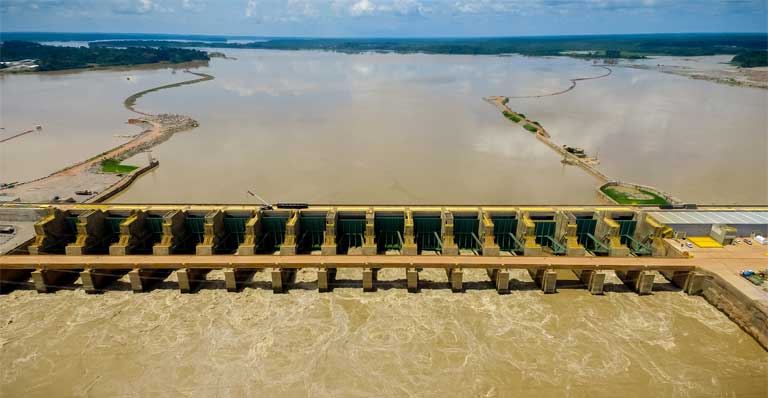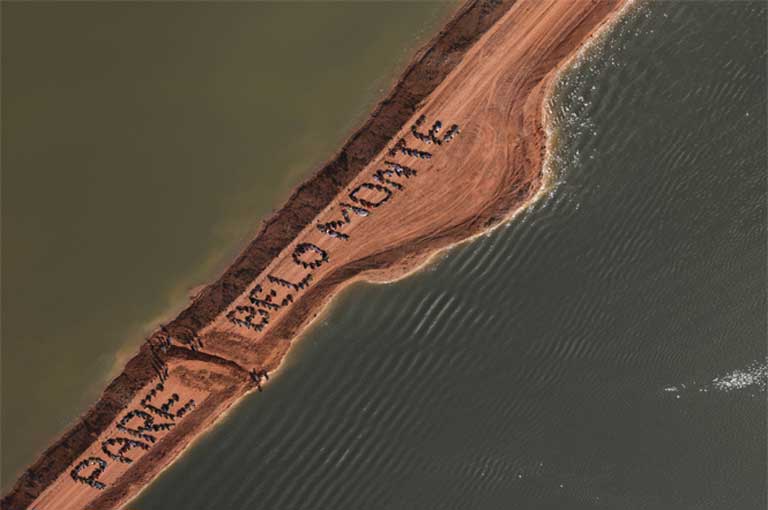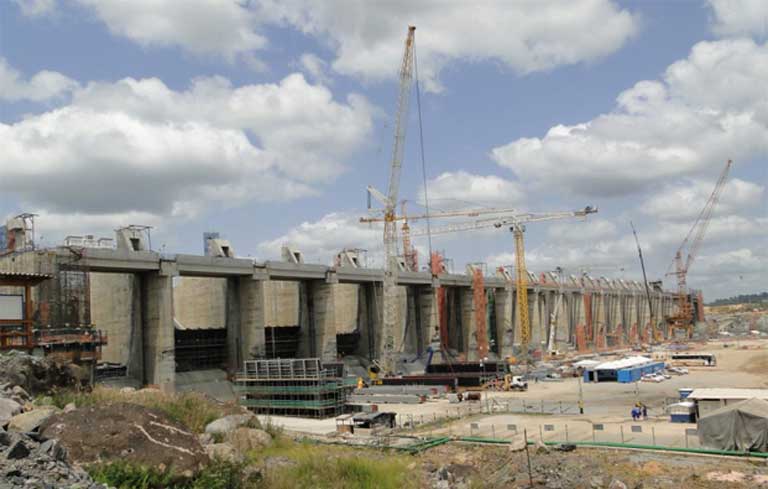- Flood pulses are critical to the way the Amazon, its tributaries and other tropical rivers function – and these seasonal flood pulses are a huge driver of ecological productivity and diversity.
- Floodplain forests depend upon annual flood pulses to bring nutrients and sediment from river channels out into the surrounding terrestrial habitat.
- Reductions to flood pulses, brought by Amazon dams both large and small, could lead to shifts in tree species diversity and composition, with implications for carbon storage and emissions.
- Unreliable flood regimes, as created by dams of all sizes, significantly impact Amazon river systems and species’ life cycles, population dynamics, food sources, and habitats above and below the water line.

According to a recent study, ecologically important flood pulses along Amazonian rivers are being substantially altered by hydropower dams. The study also finds small dams are having a disproportionately higher impact on river hydrology relative to larger dams in the region.
The new research, led by Kelsie Timpe of the University of Florida, assessed river flow both before and after construction of dams in the Brazilian Amazon.
Researchers set out to quantify the hydrological effects of dams, and identify dam characteristics that help predict the type and scale of multiple impacts. Timpe’s co-author, David Kaplan, also of the University of Florida, explains that the two undertook the study recognizing “the widespread expansion of dams in the Amazon will have a cascade of physical, ecological, and social effects, and central to those changes are how dams modify river hydrology.” Though the Brazilian government has just unofficially announced an end to its mega-dam building policy, many dams of varying size are currently planned for Amazon tributaries.
The new research has been welcomed as both “timely and important” by Isabel Jones, of the University of Stirling, UK, whose research focuses on the ecological impacts of the Balbina mega-dam, on the Uatumã river, Brazil. Though not involved with the latest study, she says it “provides a first step towards developing more robust impact assessments and mitigation strategies for existing and proposed dam development across globally important watersheds, such as the Amazon Basin.”
The study analysed 33 specific parameters of the flow regime within five broad categories: magnitude, frequency, duration, timing, and the change rate of the river’s flow. These factors were chosen because they are inextricably linked with species ecology and adaptation within the region. Changes to any one of these categories have ramifications for species lifecycles, population dynamics, and habitat availability above and below the water line.

Large and small dams, big impacts
An initial research challenge involved finding gauging stations, located both upstream and downstream of Amazon dams, that could provide comparisons between conditions before and after dams were built. In total, 40 stations, associated with 33 dams, were found to have been running long enough to be suitable for analysis. The dataset encompassed 17 large dams with a generating capacity of at least 30 megawatts, and 16 small dams with a generating capacity between 1 to 30 megawatts. Station positioning made it possible to assess the cumulative impact of multiple dams on the same river.
The study revealed an overall 30 percent change in hydrology due to the dams, with wide variation between individual stations. For instance, a hydrological change of over 100 percent was noted in the case of the Balbina dam, and recorded as low as 10 percent at stations in the vicinity of the Tucurui dam on the Tocantins River.
Significantly, Timpe and Kaplan found that a dam’s greatest effect was on the frequency and duration of high and low water events – the extremes of the flood pulse – and the rate at which the water level changed. Downstream impacts were generally greater than upstream. When multiple dams were built on the same river, cumulative impacts were incremental across all categories of study, but more pronounced for flood pulse frequency, duration and rate of change.
The study also demonstrated that the best predictors of hydrological impact were dam elevation and reservoir size. These two factors are frequently connected, as low-elevation dams often allow widespread flooding. Many of the dams currently under construction or planned in the Amazon lowlands are in this category. That large, low-elevation reservoirs such as at Balbina have major impacts was not surprising, said Kaplan, “but the picture changed significantly once dam generating capacity was taken into account.”
When study results were scaled to reflect the hydrological impact per unit of energy generated, “small dams caused particularly high levels of hydrologic alteration relative to their potential electricity production,” said Kaplan. Some were even worse, per unit of energy, than a larger dam like Balbina. “This is particularly troubling given the lower permitting and monitoring requirements for these small systems.”

Ecological effects
For species living within and alongside Amazonian rivers, unpredictable changes to the annual flood pulse are bad news. The flood pulse “is critical to the way that the Amazon and other tropical rivers function and a huge driver of why they are so productive and diverse,” notes Kaplan.
“Water provides a significant part of the physical structure which fish, as well as many other aquatic biota, live in,” explains Leandro Castello, a researcher of Amazonian fish ecology and conservation at Virginia Polytechnic Institute and State University, “so even the smallest changes can have profound effects on them. For example, a small decrease in the maximum water level reached by a river annually can mean the loss of large areas of feeding and nursery habitat.”
Kaplan agrees, and further notes that these changes can disrupt “natural spawning cues and trap aquatic organisms in floodplain lakes or strand terrestrial organisms on floodplain islands,” as well as reducing invertebrate abundance. This all has a pronounced effect on the fish, birds, and other animals that feed on invertebrates and other food enhanced by flood pulses. “We found the impacts on the hydrological regime could be seen as far as 300 kilometers (186 miles) away,” Kaplan says.
Put simply, the forest itself needs the floods to continue being highly productive and diverse: the floodplain is bathed in nutrients and sediment when water levels rise. Floodplain forests, which “hold significant stocks of carbon,” are therefore vulnerable to changes in the flood pulse, says Jones. The focus of her research, the Balbina mega-dam, is the worst ecological offender in Timpe and Kaplan’s analysis.

Jones warns that a reduction in the flood pulse could lead to a change in species composition and interactions within the floodplain forest “such that carbon storage capacity is reduced,” which could lead to an increase in carbon emissions, bad news for the global climate.
During her research at the Balbina dam, Jones witnessed the problems that arise for dam operators when reservoir levels drop during drought. “Under a changing climate, such low-flow periods may become increasingly common, and thus the dam-induced hydrological impacts revealed in the study by Timpe and Kaplan could well increase.”
Study results should spur change
In light of the hundreds of dams, both large and small, that are planned or under construction across the Amazon, this study could help point the way to minimizing the ecological damage they will cause, Kaplan says. “We hope that these results can help motivate planners and policymakers to critically assess just how sustainable dams are as an alternative to other energy sources (wind and solar), particularly given the potential for tropical reservoirs to emit substantial amounts of methane, a powerful greenhouse gas.”
Political pressure continues to exist in Brazil to push forward with small- and medium-sized dam construction, especially to meet energy needs for the mining industry and for agribusiness, so “reducing environmental impacts is critical, including by optimizing dam operations to more closely mimic the natural flow regime, in other words, lowering the hydrological alteration in our study,” Kaplan urges.

But, Castello warns, the analysis by Timpe and Kaplan likely exposes just “the tip of the iceberg” regarding dam impacts on hydrology. Kaplan sees an urgent need to consider other kinds of impacts, particularly when considering the optimum size and siting of dams to minimize harm. “Location really matters for dam impacts, not only on hydrology, but also, for example, to migratory fish passage and impacts on human communities.”
“Our analysis does not assess how dams and reservoirs affect biotic connectivity,” Kaplan points out, nor did it address the disruption to the vital flow of sediment from Andean headwaters to the Amazon basin and estuary.
“Without a more critical look at the impacts of dams, and ways to better mitigate their impacts, the outlook for the Amazon and its tributaries is not great,” Kaplan says, adding that “citizens of countries with dam building booms should also be involved in asking difficult questions,” such as “how much biodiversity loss, fisheries productivity decline, and human rights violations are we willing to trade for these projects?”
Citation:
Timpe, K. and Kaplan, D. (2017) The changing hydrology of a dammed Amazon. Science Advances 3: e1700611

